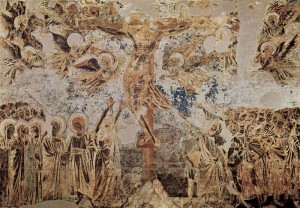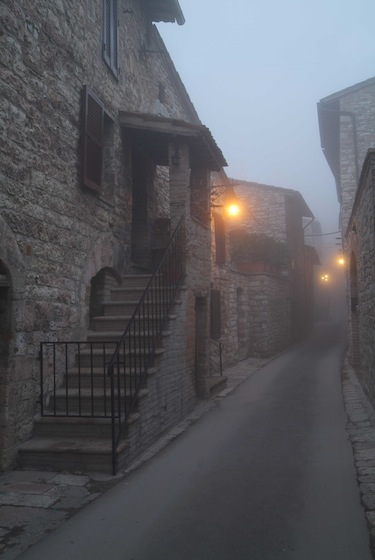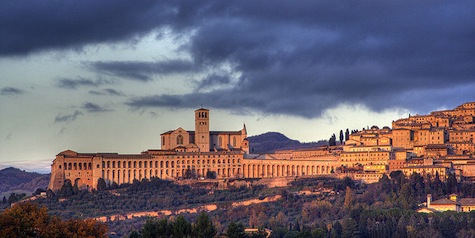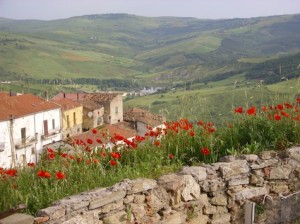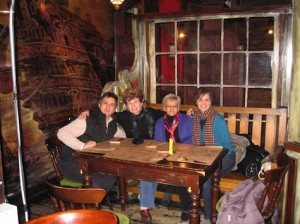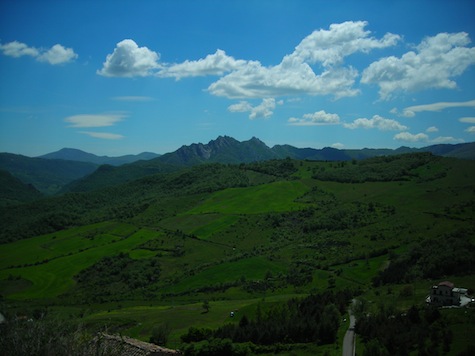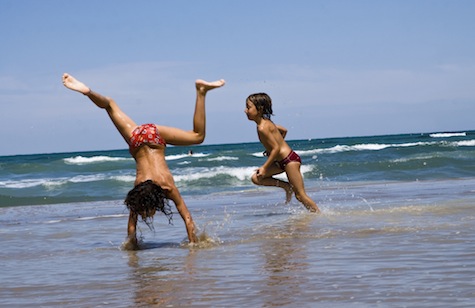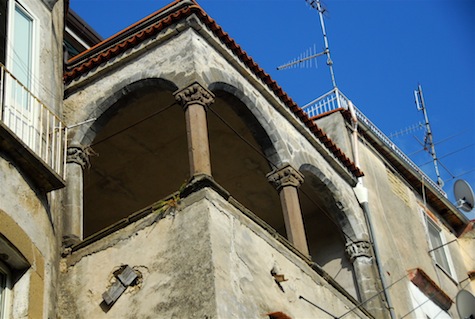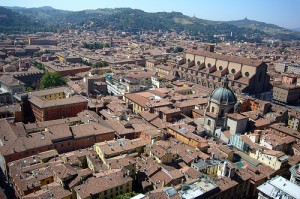Archive for the ‘gita italiana’ Category
Gita Italiana 2010: How to Really Love Assisi
 Welcome back to another day on the Gita Italiana — do you need a rest yet? Sorry, you won’t be getting one until August is over!
Welcome back to another day on the Gita Italiana — do you need a rest yet? Sorry, you won’t be getting one until August is over!
Today we’re spending time getting to know and love Assisi with Rebecca Winke of Rebecca’s Ruminations; you may also know her as one of the driving forces behind the Agriturismo Brigolante in Umbria. Welcome Rebecca!
*
There’s a tipping point on the eternal scale of love.
At the beginning, you fall for the love of your life for the big things—her eyes, her smile, the way she walks—in short, those same things that have smitten every guy who has come before you and are still what make heads turn. But slowly, over time, your focus shifts and at a certain point you realize that what you love about her now are the little things, details so small and intimate that you feel like you, and only you, know. The way she looks sad when she talks about her grandfather, how she bites her lip when she’s nervous, her secret stash of Phil Collins albums. And though she may be admired the world over for the big things, it’s those little ones that make her yours.
This is where I’m at with Assisi. Years ago I fell in love with her for the big things—the Basilica of Saint Francis, the winding alleys lined with pink stone houses, the pretty piazza—all of those things that have struck visitors for centuries before me.
But now, after almost 20 years of living here, I love her for the small things, my private collection of quirks that makes me feel like we belong together.
Her Checkered Past
Sure, your woman is a staid mater familias now, admired for her domestic organization, professionalism, and civic activism. But you know. You know she shies away from tank tops and sundresses because of that tattoo on her shoulder, the one she now finds tacky and slightly embarrassing, but which is the only remaining evidence of a ten-month long teen rebellion that involved quitting school, thumbing it to California, hooking up with a ne’er-do-well group of hemp activists, and finally having to call collect from a biker jamboree in one of the Dakotas for money to fly home and shower. And you love that tattoo.
Assisi is all peace and love and Saint Francis now. But I know. I know her past as a scrappy little warmonger, wreaking havoc in neighboring Perugia and Arezzo and taking up arms at the drop of a hat (for better or for worse) against Rome, the Byzantine empire, and the Lombards (amongst others). Today, Assisi is admired for her Basilica (the one dedicated to Saint Francis who was, before his religious conversion, a fierce merchant-warrior who survived numerous battles and captivity), but I love to visit one of the only vestiges of her bellicose past: the captivating and dramatic Rocca Maggiore, her stone fortress set above the town. I wander through the semi-restored tunnels and turrets, and climb the far tower to gaze over the whole of the Umbrian valley with a conquerer’s eye. I know.
Her Chipped Tooth
Everyone loves her smile because it’s perfect; you love it because you know it’s not.
Whenever I visit the Basilica, I always stop to admire the famous fresco cycle in the upper church documenting the life of Saint Francis, with its breathtaking first steps towards conveying depth and perfect rendering of facial features. But what I spend most my time in front of is Cimabue’s magnificent Crucifixion decorating the apse, with St. Francis on his knees at the foot of the Cross. Because the artist used lead oxide in his colours, which were applied when the plaster was no longer fresh, the frescoes soon suffered from damp and decay and deteriorated to photographic negatives. Somehow seeing a great master’s “Doh!” moment makes all the perfection just a little more human and lovable.
What’s Really Important to Her
You’ve heard her hold forth at dinner parties about travel, food, wine, shopping, and all six seasons of SATC. But you’ve also listened to her read pages from her diary out loud to you in bed. You know what she would run back into the burning house to save.
Assisi has shops, restaurants, music and arts festivals, religious feast days, nattily dressed inhabitants, and many, many cell phones. But if you really want to see what makes this town tick, take the pretty walk past Porta San Giacomo to the cemetary. Aside from being architecturally lovely in that way that old monumental European cemetaries so often are, here you will discover the soul of Assisi. Notice the names on the stones that repeat over and over, as generations live out their lives in this small town. See the carefully tended graves, as women return every week to freshen flowers and polish marble. Watch as they tenderly touch the portraits attached to the graves and quietly greet their loved ones. Assisi would run back into the burning house to save her family.
How She Sleeps
Nothing is more intimate than looking down on your love’s face while she sleeps, and, indeed, the winter months when the tourists have left and Assisi seems to have fallen into quiet repose is when I feel closest to her. I wander her silent streets on a misty February night, hear the echo of my footsteps, discover alleys and winding staircases, and have only the occasional cat or church bell tolling as company. Everyone loves her when she’s awake and vibrant in the sunshine; I love her when she’s all shuttered up in the fog.
She Can Still Dazzle You
Yes, you are over the big stuff. But every once in awhile she comes down the stairs dressed for an evening out and manages to leave you breathless and head-over-heels in love again.
I see Assisi every day. I admit I get inured to her beauty after awhile. And then there will be that one magical fall evening when I’m headed up the hill and the light is just the right shade of dusk to set the whole town ablaze in pink and orange and the sky is an improbable azure and the mountain she perches on is an autumn firestorm and the air is so limpid that you can see every detail to postcard perfection and I am so smitten that I pull the car over and put my life on hold for ten minutes to watch my beautiful Assisi in all her glory. And I think, “It’s you and me, baby. We’re in it for the long haul.”
*
Rebecca moved to Italy from Chicago in 1993 and shortly thereafter opened an agriturismo in her husband’s renovated family farmhouse at the foot of Mount Subasio near Assisi, Umbria. She spends her time taking care of guests at Brigolante, blogging about the lovely region she now calls home at Rebecca’s Ruminations, and wondering about what strange winds blew an urban vegetarian to a pig farm in Umbria.
Gita Italiana 2010: At Home in Basilicata – The Forgotten Region
 Next stop on the Gita Italiana is Calabria’s neighbor to the north, Basilicata, thanks to Valerie Schneider of 2 Baci in a Pinon Tree. Welcome Valerie!
Next stop on the Gita Italiana is Calabria’s neighbor to the north, Basilicata, thanks to Valerie Schneider of 2 Baci in a Pinon Tree. Welcome Valerie!
*
When I tell people that I bought a house in Italy, the usual response is, “How fantastic! When I tell them it’s located in Basilicata, they get a blank look and say, “Where?”
Basilicata is possibly the least-known region in the peninsula. It is cuddled between Puglia, Calabria and Campania and is the most sparsely populated part of the country. Its ancient name is Lucania, and while it’s been renamed Basilicata, the inhabitants are still known as Lucani.
Little is written about the region, and what is published generally refers to it as “poverty-stricken” or “backwards.” Basilicata is misunderstood, underappreciated and overlooked.
Even among Italians it isn’t well-known.
Our first trip south was to explore my family heritage. We arrived in a remote mountain village expecting to find squalor based on the only English-language descriptions I could find at the time, but met instead with a well-kept town that clung desperately to its rocky peak. We meandered the insanely-steep streets and were greeted with smiles and stares. We discovered I still had familial ties there.
Those first forays into the Motherland garner us outright stares. Let’s face it, a little town of 2,000 souls that is perched on top of a mountainside at 1,000 meters surrounded by rural farms and sheep in southern Italy does not draw many Italian tourists, much less foreigners. We quickly came to realize that behind their curious smiles was a real desire to assist and a strong pride in their towns and traditions. Several trips and many wonderful, welcoming experiences tied up our heart-strings with a bow.
The more we explored Basilicata the more we were smitten. The natural beauty and the genuine warmth of the people completely won us over.
While she dips two toes into two seas, Basilicata does not embody the typical Mediterranean image one may have of Italy. The landscape is rocky and rugged, even primitive. It has a unique and raw beauty. From the plains of Puglia the earth turns wavy with billowing wheat. Then it ascends to rolling hills punctuated with olive groves and grape vines, where world-class wine is made from ancient Grecian grapes. Time-worn villages cling to ridges and hilltops. From there the region soars upwards into alpine mountains ribboned with rivers and sliced with gorges. In the high altitude the air is clear and millions of stars cast an amazing display. Butterflies dance in the sun, and eagles and falcons guard the skies. And the Lucani welcome visitors with curious glances and open smiles.
We knew we would always return to this fascinating, beautiful land, so it just made sense to buy a small place that we could call our own. Our little casa, at about 300-years old, has more time on it than our New World country.
Guidebooks call it poverty-stricken but we found there is a very rich culture there. They say it’s backwards, but we say it just clings to time-honored traditions. We love walking the medieval stone streets and feeling surrounded by hundreds of years of history and simplicity. Our neighbors have accepted us as ordinary villagers, we’ve made friends — we feel at home. And there is nothing backwards about that.
*
Valerie Schneider is a freelance writer and travel professional, a cappuccino addict, and a Lucana at heart. She writes about off-the-beaten-path Italy on the Web site, Italy Panorama. You can read more of her adventures at her blog, 2 Baci in a Pinon Tree.
*
Grazie mille Valerie!
Be sure to come back for tomorrow’s gita to Assisi!
Gita Italiana 2010: When I Was Two, I Was Nearly New
 Today’s stop on the Gita Italiana comes to us via Kate Bailward of Driving Like a Maniac; this post was originally published on Kate’s blog earlier this summer.
Today’s stop on the Gita Italiana comes to us via Kate Bailward of Driving Like a Maniac; this post was originally published on Kate’s blog earlier this summer.
Welcome Kate!
*
‘… la bimba?‘ I look up. There’s a two year old in a pink bikini standing in front of me with an enquiring look on her face. I realise too late that she was asking me a question. I have absolutely no idea what the question was, but it seems she wants an answer. I’m stumped. I settle for saying ‘si‘ with a bit of an upward inflection and hoping that it will head her off at the pass. Nope. She repeats again, and again all I catch is ‘la bimba.’ Is she asking where my daughter is? I look confuddled. She tries another tack. ‘Dov’è il tuo amico?‘ Well, actually he’s administering an exam for my PON students in Scorrano today, but I have no idea how to say that in Italian, so instead I smile and tell her it’s just me. This, it appears, is not the right answer. She seems to feel that it’s a bit improper for me to be on the beach on my own. She may have a point, actually. I submit to her attempts to engage me in conversation. She’s now saying something about being sandy. I nod vociferously. ‘Si, si – sabbiata!’ She sighs and rolls her eyes at me. I’m not sure she’s realised that I’m English, as opposed to being very stupid, but she doesn’t seem to mind too much, and it’s good practice for me to have to speak to someone who gives no quarter.
She sashays over to her pile of plastic toys and returns with one as a gift for me. ‘Guarda! Pesciolino!’ I point out that it’s blue. She gives me an old-fashioned look. Ah. Clearly she knew that already. It seems she’s erring on the side of stupidity as regards her assessment of me, as she collects a second toy and waits for me to point out that it’s yellow. When I do so, she smiles proudly. Her parents, in the water, are giving me very disapproving looks, seemingly being convinced that I’m some kind of nutter. I therefore beckon the girl to follow me and replace her toys in the pile with the rest of them. Her mother, with a face like someone sucking a lemon, then summons her daughter. ‘Martina! Vieni!’ Martina isn’t too keen on this idea, being more interested in carrying on chatting to me, but her mother isn’t having any of it and swoops in to pick her up and wade back out into the water, where the strange NON-ITALIAN can’t corrupt her. I laugh inwardly and return to my book.
There’s another young boy and his dad playing on the other side of me. The little boy, I gather, is called Gianluca, and is having a whale of a time filling up a miniature watering can and then pouring the contents into a bucket. Sandcastles? Nah. Digging holes? Nope, not interested. Pouring water from one receptacle to another? BRILLIANT. Dad is going demented blowing up dinghies and armbands, but he’s wasting his time. Simple pleasures really are the best when you’re two.
A mum and her young son come onto the beach. It seems that this isn’t a planned visit, as she’s wearing high heels and his arm is in a cast. He’s desperate to go in the water, and she concedes, although fusses about him getting his shorts wet. He merely grins and rolls them up, negating her argument in one fell swoop. She shrugs and settles herself down on the beach to watch him paddle. In the meantime, Gianluca has bored of water transferral and has been coerced by dad into pottering about with a fishing net. There are, surprisingly, given that there are so many people in the water, some pretty big fish swimming about, but Gianluca isn’t interested in those. No, he wants the little black crabs scuttling along under the seaweed, and is concentrating on his task intently. Inevitably, the boy with the broken arm is desperately curious to know what’s going on, and creeps ever closer to try to catch a peek. Finally, he makes contact with Gianluca, and joins in the game. It transpires that his name is Tomaso. I know this because his mother shrieks across the beach at him when she realises that he’s getting his shorts absolutely sodden. She bustles over to tell him off and, realising it’s a lost cause trying to to keep them rolled up, whips them off him and lets him go paddling in his pants. It’s a disaster waiting to happen as regards his cast, of course. Five minutes later he’s delving too enthusiastically into the bottom of the fishing net and dunks his cast into the water up to the elbow. Mum, scolding fit to burst, drags him out of the water and off the beach. He trails, dejected, behind her, casting wistful glances back at Gianluca, who has forgotten him already and is shouting with glee at having found a big crab scrabbling around at the bottom of his net. Il bambino è mobilè.
Kate Bailward (aka Katja) is a trifle-hating, cat-loving English girl who moved from London to the Salento region in southern Italy in October 2009 to teach English. The Italians, meanwhile, taught her how to drive like they do – giving rise to her blog name, Driving Like a Maniac.
Having written for a year about living in the heel, in September 2010 she will be starting a new chapter in southern Calabria, and is thoroughly looking forward to discovering life in the toe.
*
Grazie mille Kate!
Next stop . . . Basilicata!
Gita Italiana 2010: The Loggia
 Today’s stop on the Gita Italiana 2010 is in Campania, and our guide is Karen Wolf of The Shock of the Old. Welcome Karen!
Today’s stop on the Gita Italiana 2010 is in Campania, and our guide is Karen Wolf of The Shock of the Old. Welcome Karen!
The Loggia
1.
‘Returning to the principal street, one can see, in the courtyard of Palazzo Polito, a cylindrical tower with a sloping base dating to the Aragonese period, flanked by a Catalan loggia with polygonal pilasters and foliate capitals carved from tuff, built upon the medieval ring wall…’ (Antonio Marcello Villucci, Sessa Aurunca: Storia ed Arte, Marina di Minturno: 1995, p.87)
2.
When I came to Sessa Aurunca to marry my husband, I moved into a house filled with a great assortment of books. I appropriated them all, filing them in amongst my own, and as I read them, I annotated their margins in pencil, marking them as mine. Among these new acquisitions was a slim volume by one Antonio Marcello Villucci, an introduction to the history and art of Sessa Aurunca, presented in the form of a walking tour. In the beginning I used it as a work of reference, flipping through its pages to find illustrations of things I had encountered on my walks around town, and scanning the accompanying text for names and dates. Later, when there were no new streets or alleys left to explore, it became something of a treasure map, directing me to the few remaining sights I had somehow overlooked. The last of these was a loggia, in the Catalan style, and the caption beneath its picture told me to look for it at Corso Lucilio, no. 98.
3.
On the Corso, the numeri civici followed a palimpsestic logic. They skipped and stopped and started again. Some buildings had no numbers at all, others as many as three. They were stenciled in red, or black or orange, or painted in blue on white ceramic tiles. Odd numbers lined one side of the street, and even numbers the other, except in the places where they appeared together. They suggested an urban history full of modifications and restorations but they did not lead me to the loggia. For weeks I parsed the architecture of the Corso for clues to its location. I examined windows and arches, and guessed at the thickness of walls. I peered into courtyards through open doors, looking for the loggia or any hint of its Catalan style. From one day to the next, these portals opened and closed, as though in a game of musical doors, or memory. I began to wonder whether the loggia was hidden behind a door that remained forever locked, or if I had simply missed every opportunity to chance upon it.
4.
One morning, months after I had abandoned my search for the loggia, I pushed my daughter in her stroller past a stone portal that I was sure I had never seen before, although its great size made me wonder if that were possible. Its arch opened onto a wide, barrel-vaulted passageway, and just beyond that was a small white-washed courtyard where a flight of stairs led to a mezzanine on the first floor. Unable to account for the feeling I had that the loggia was near, I shrugged it off and continued on our way.
A couple of weeks later, an errand took us to the same stretch of the Corso. I stared into the white courtyard as I wheeled my daughter past it. A few doors down, I paused, and sensing once again the presence of the loggia, I retraced my steps. In the barrel-vaulted corridor, I noticed a massive wooden door leaning on its long edge against a wall. From the foot of the stairs, I looked up at the mezzanine. Following it around the walls with my eyes, I turned my head to the right and noticed that the white courtyard opened onto another, much larger one. Along its far side was a tall, nondescript apartment house, and to the left and right, two rows of garages, their doors painted green.
“Where are we going, Mommy?” my daughter asked.
“Home, baby. There’s nothing here,” I told her.
5.
On the night of Pasquetta, we descended the Corso under glimmering, golden lights. We passed the candle-lit church of San Giovanni in Piazza and then the palazzo where twice before I had sought the loggia. In the quiet calm of the darkened street, I sensed the town speaking to me with a golden resonance. “Can we go in there for a minute?” I asked my husband, indicating the great stone arch.
‘What is this place?’ he wondered aloud once we had entered white courtyard.
“Wait here,” I told him, “I think I’m about to find what I’ve been looking for.”
I walked into the darkness of the second courtyard and turned slowly to face the entrance. Raising my hand to shade my eyes from the light shining beyond the arch, I perceived, directly to the right of it, the mass of a cylindrical tower, and as my vision adjusted to the darkness, the profile of the loggia.
*
Karen Wolf is an art historian living in the Campania region of southern Italy. When she’s not on the hunt for architectural treasure, she blogs as KC at The Shock of the Old.
Gita Italiana 2010: Taking a Break, Italian Style
 Today’s featured Gita Italiana writer is Julie Angelos of Jbulie’s Blog, who gives us a little background on what happens in August in Italy and a few ideas on where to go.
Today’s featured Gita Italiana writer is Julie Angelos of Jbulie’s Blog, who gives us a little background on what happens in August in Italy and a few ideas on where to go.
Welcome Julie!
Taking A Break, Italian Style
Ferie d’Agosto (Ferragosto) is an Italian national holiday on August 15th when all stores are closed and most people head to the coasts or the mountains.
The actual date happens to coincide with my best friend’s birthday so it makes it easy for me to remember. I was actually shocked and surprised my first year living in Italy that nearly ALL of Italy closes for August. I don’t mean all of August, just that almost ALL Italians take a holiday in August somewhere.
I’m certain that this is due to the heat and the fact that schools are closed. I did a little investigative research the first year I moved here by asking my Italian friends where and when they were going. What I got was all over the world that included Thailand, Mexico, the coast, Sardinia, Sicily, U.S.A, France, England ~ just about anywhere actually.
Most Italians take a couple weeks of vacation from 10 days to as much as 60. Well, I took 58. Does that count? I’m also known to go overboard. Unfortunately, airline prices rise accordingly making the high season tickets double the low season fares.
I live just outside of Bologna which is an hour north of Florence, and a couple hours by train or car south of Venice and Milan. It’s considered northern Italy, although I feel like it’s quite centrally located. I remember reading somewhere that ninety percent of trains in Italy pass through Bologna.
In August, the streets become suddenly empty. All of the stores pull down their rolling metallic doors to lock them up. The newspaper prints an article on the stores that are OPEN instead of closed. Transport is limited or toned down. Car traffic is pretty grueling.
Where to go?
My favorite getaways in Italy are Venice, Florence, Assisi, the Lakes and Cinque Terre. A lot of people like to go up to the mountains to get away from the heat. I lived a year in Florence and that city still is on my top beautiful cities in the world together with Paris and San Francisco.
Maybe you have heard about Stendhal’s syndrome?
What happens is this: you are walking through one of the most magnificent historic city centers in the world when all of a sudden a small square opens up to reveal the big beautiful cathedral called the Duomo with its glorious cappello designed by Brunelleschi. I don’t know if you’ve ever seen it, but for me and my friends it was a jaw-dropping experience.
I felt I was looking at all of humanity’s compassion and ability wrapped in pretty tri-colored marble ribbon. Don’t get me wrong, there is no bow or ribbon on the Duomo; it’s just a metaphor to describe a pretty present left to posterity. One word of caution, though: one year while walking around Florence in August, my girlfriend refused to come with me. Too hot, she said. She might have been right.
Wherever you decide to travel in August, I like to remember that it’s always nice to get away, yet it’s always nice to come back home too.
*
Julie Angelos is a teacher and writer who moved to Italy on a whim when she was 30 and still lives here with her husband and two sons. You can find her at Jbulie’s blog and @jbuliesblog on Twitter.


